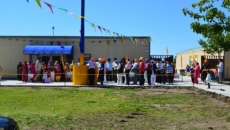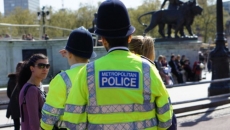JERUSALEM (AP) — Israeli warplanes hammered the Gaza Strip neighborhood by neighborhood on Tuesday, reducing buildings to rubble and sending people scrambling to find safety in the tiny, sealed-off territory now suffering severe retaliation for the deadly weekend attack by Hamas militants.
Humanitarian organizations pleaded for the creation of corridors to get aid into Gaza, warning that hospitals overwhelmed with wounded were running out of supplies. Israel has stopped entry of food, fuel and medicines into Gaza, and the sole remaining access from Egypt shut down Tuesday after airstrikes hit near the border crossing.
The war, which has already claimed at least 1,800 lives on both sides, is only expected to escalate. The weekend attack that Hamas said was retribution for worsening Palestinian suffering under Israeli occupation has fired Israel's determination to crush the group's hold in Gaza — hiking risks of an expanded regional conflict.
Canadian Prime Minister Justin Trudeau shared a message of unity for Israel.
Canada unequivocally condemns Hamas’ attack against Israel – and we stand united with the Israeli people. That was the message I shared with Ottawa’s Jewish community and everyone at yesterday’s solidarity gathering. pic.twitter.com/iBfEJNWHY7
— Justin Trudeau (@JustinTrudeau) October 10, 2023
Hamas militants stormed into Israel on Saturday morning, slaying hundreds of residents in homes and streets near the Gaza border and bringing gunbattles to Israeli towns for the first time in decades. Hamas and other militant groups in Gaza hold about 150 soldiers and civilians hostage, according to Israel.
Israel was now stepping up its offensive. It expanded the mobilization of reservists to 360,000 on Tuesday, according to the country’s media. After days of fighting, Israel’s military said Tuesday morning that it had regained effective control over areas Hamas attacked in its south, and of the Gaza border.
A looming question is whether Israel will launch a ground assault into Gaza — a 40 kilometer-long (25 mile-long) strip of land wedged among Israel, Egypt and the Mediterranean Sea that is home to 2.3 million people and has been governed by Hamas since 2007.
On Tuesday, a large part of Gaza City’s Rimal neighborhood was reduced to rubble after warplanes bombarded it for hours the night before. Residents found buildings torn in half or demolished to mounds of concrete and rebar. Cars were flattened and trees burned out on residential streets transformed into moonscapes.
Palestinian Civil Defense forces pulled Abdullah Musleh out of his basement together with 30 others after their apartment building was flattened.
“I sell toys, not missiles,’’ the 46-year-old said, weeping. “I want to leave Gaza. Why do I have to stay here? I lost my home and my job.”
The Israeli military said it struck hundreds of targets in Rimal, an upscale district home to ministries of the Hamas-run government, universities, media organizations and the aid agency offices.
In a new tactic, Israel is warning civilians to evacuate neighborhood after neighborhood, and then inflicting devastation, in what could be a prelude to a ground offensive. On Tuesday, the military told residents of the nearby al-Daraj neighborhood to evacuate, and soon after new explosions rocked the area, and Rimal, continuing after nightfall. One strike hit Gaza City's seaport, setting fishing boats aflame.
“There are no safe place in Gaza right now, you see decent people being killed every day,” Hasan Jabar, a Gaza journalist, said after three Palestinian journalists were killed in the Rimal bombardment. “I am genuinely afraid for my life.”
Tuesday afternoon, Hamas fired barrages of rockets toward the southern Israeli city of Ashkelon and Tel Aviv. There were no immediate reports of casualties.
Israel's new tactics could point to its new objective.
Four previous rounds of Israel-Hamas fighting between 2008 and 2021 all ended inconclusively, with Hamas emerging battered but still in control. This time, Israel’s government is under intense pressure from the public to topple Hamas, a goal considered unachievable in the past because it would require a reoccupation of the Gaza Strip, at least temporarily.
“The objective is for this war to end very differently from all of the previous rounds. There has to be a clear victory,” said Chuck Freilich, a former deputy national security adviser in Israel. Weakening Hamas was not enough, “whatever has to be done to fundamentally change the situation will have to be done,” he said.
The devastation also sharpened questions about Hamas' strategy and objectives. Hamas officials have said they planned for all possibilities, including a punishing Israeli escalation. Desperation has grown among Palestinians, many of whom see nothing to lose under unending Israeli control and increasing settlements in the West Bank, the blockade in Gaza and what they see as the world’s apathy.
Hamas may have been counting on the fight to spread to the West Bank and possibly for Lebanon’s Hezbollah to open a front in the north. But while four days clashes between rock-throwing Palestinians and Israeli forces in the West Bank have left 15 Palestinians dead, Israel has clamped down heavy on the territory, preventing movement between communities.
Brief exchanges of fire across Israel's northern border have taken place nearly daily — with six rockets fired from southern Lebanon into Israel Tuesday evening, followed by Israeli artillery response. But so far they have not escalated.
In hopes of blunting the bombardment in Gaza, Hamas has threatened to kill one Israeli civilian captive any time Israel targets civilians in their homes in Gaza “without prior warning.” Israel’s foreign minister, Eli Cohen, warned in response that “this war crime” would not be forgiven.
The militants’ attack stunned Israel with a death toll unseen since the 1973 war with Egypt and Syria — and those deaths happened over a longer period of time. It brought horrific scenes of Hamas militant gunning down civilians in their cars on the road, in streets of towns, and at a music festival attended by thousands in the desert near Gaza, while dragging men, women and children into captivity.
The Israeli military said Tuesday that more than 1,000 people have been killed in Israel. In Gaza and the West Bank, 830 people have been killed, according to authorities there; Israel says hundreds of Hamas fighters are among them. Thousands have been wounded on both sides.
The bodies of roughly 1,500 Hamas militants were found on Israeli territory, the military said. It wasn’t immediately clear whether those numbers overlapped with deaths previously reported by Palestinian authorities.
In Gaza, more than 200,000 people have fled their homes, the U.N. said, the most since a 2014 air and ground offensive by Israel uprooted about 400,000. The vast majority are sheltering in schools run by the U.N. agency for Palestinian refugees. Damage to three water and sanitation sites have cut off services to 400,000 people, the U.N. said.
On Monday, Israel announced a “complete siege” on the territory, halting deliveries of food, fuel, water, medicines, electricity and other supplies. That leaves the only access in and out through the Rafah crossing with Egypt.
But that too was shut down Tuesday after Israeli strikes raised palls of smoke nearby and sent families waiting with suitcases for a chance to get out running for cover. A day earlier, the Egyptian Red Crescent managed to get in one shipment of medical supplies.
Egyptian officials were talking with Israel and the U.S., pushing to set up humanitarian corridors in Gaza to deliver aid, an Egyptian official said. There were negotiations with the Israelis to declare the area around the Rafah crossing between Egypt and Gaza as a “no fire zone,” the official said, speaking on condition of anonymity because he was not authorized to talk to the media.
The U.N.’s World Health Organization said that supplies it had pre-positioned for seven hospitals in Gaza have already run out amid the flood of wounded. The head of the medical aid group Doctors Without Borders said surgical equipment, antibiotics, fuel and other supplies were running out at two hospitals it runs in Gaza.






